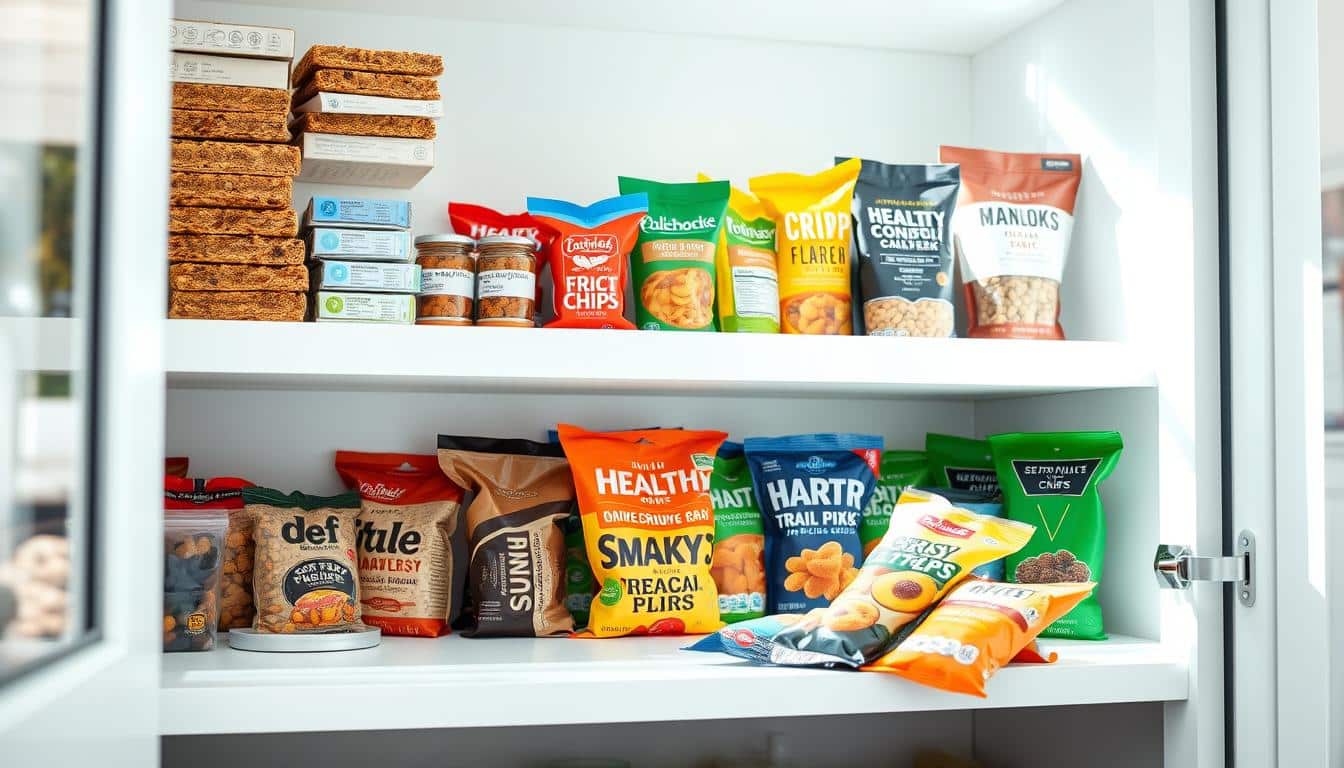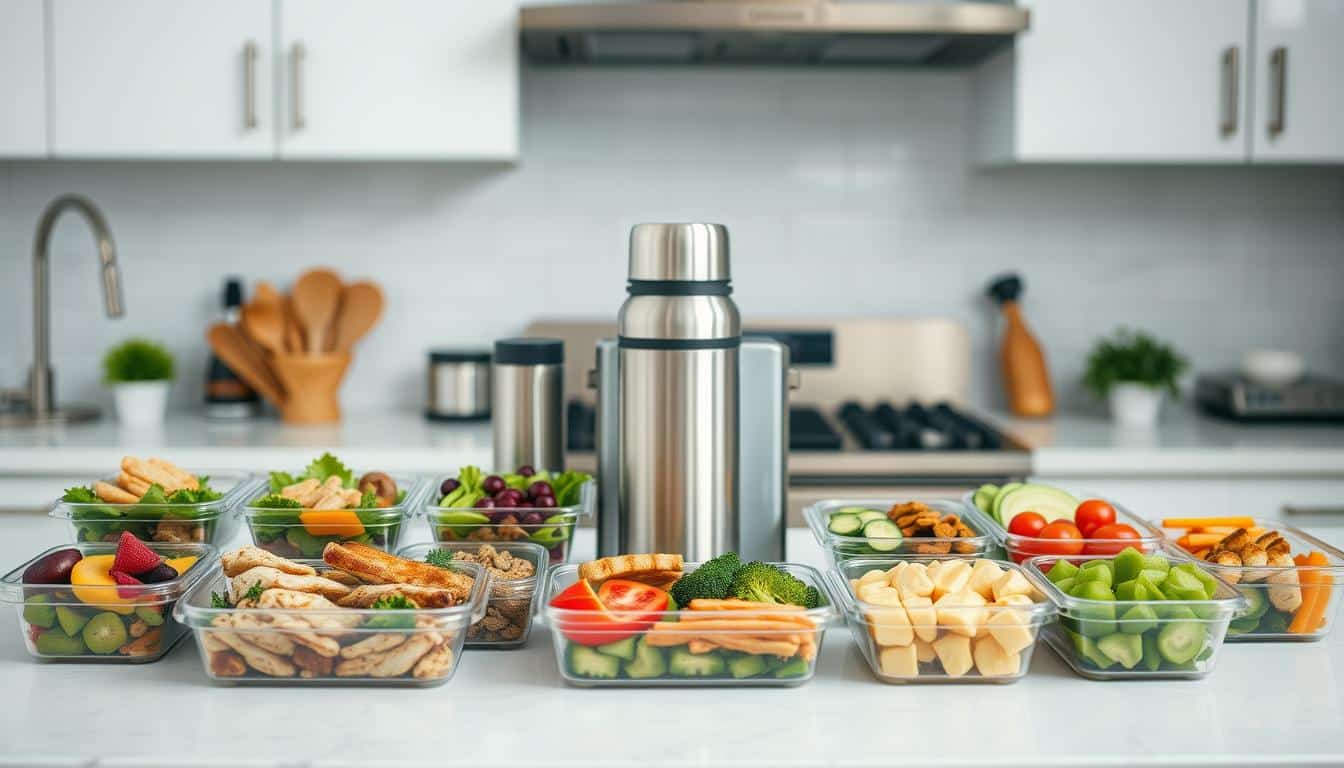Today’s diverse workplaces require more allergen-free lunch choices than ever. Recognizing the challenges of those with food allergies is key. Safe lunch options reduce allergy risks, boost well-being, and encourage harmony.
This article will look at allergen-free lunches. It will show why understanding food allergies is important. Also, it will share ways to make the workplace safer for everyone.
The Importance of Allergen-Free Lunch Options in the Workplace
Food allergies are a big concern in diverse workplaces. They need careful food allergy management. Offering allergen-free lunch options enhances safety and promotes inclusivity. It is crucial as employees with food allergies risk health emergencies from cross-contamination. Thus, office meals should meet their needs.
Allergic reactions can seriously impact health and workplace morale. A safe place to eat makes employees happier and more productive. By serving allergen-free meals and clearly stating what’s in the food, employers show they care about everyone’s health.
Making lunch spaces allergen-aware invites everyone to take part without fear. This makes employees feel they belong and boosts team spirit. Employers should see that allergen-free meals greatly improve the workplace atmosphere.
Creating An Allergen-Free Environment
Creating a space without allergens is key to keeping workers safe and happy. Leaders should talk about health rules for allergens. This makes employees more involved in making their workplace safer, improving kitchen safety culture.
For better safety, it helps to have special areas for allergen-free meals. These could be separate areas or tables for such meals. Keeping these places clean is very important. Regular cleaning stops different food from mixing, making it safe for everyone.
Also, putting up signs about allergen-free areas is a good reminder. These signs help employees remember the importance of kitchen safety. They remind everyone to look out for each other’s health and safety.
Communication with Coworkers about Allergies
Talking about allergies at work is key to keeping everyone safe. It’s important that everyone feels they can talk freely about their food allergies. This way, everyone knows what foods to avoid to keep the workplace safe.
When talking about allergies at work, it’s good to be kind and understanding. Starting a conversation in your team about allergies can make everyone more aware. By sharing what you go through, others can understand the challenges of living with allergies.
Educational sessions about food allergies can really help everyone know more. These sessions can teach what causes allergies, how to avoid allergens, and what we can all do to help. Encouraging questions in these talks helps everyone learn and work together to make the workplace safer.
Elevator-Safe Allergen-Free Lunch Options for the Office
Finding allergen-free lunch options for work is hard. Look for meals that are safe to eat in an office. These should keep fresh and avoid allergy issues. Choose these when planning your office lunches.
Examples of Safe Lunch Items
Here are some safe lunch ideas:
- Salads topped with grilled chicken and a vinaigrette dressing
- Pre-packaged fruits, like apple slices or mixed berries
- Vegetable wraps filled with hummus and assorted veggies
- Allergen-free snacks such as popcorn or rice cakes
These options are healthy and work for different diets. They keep everyone full and focused at work.
Benefits of Designating Allergen-Free Zones
Having allergen-free areas at work means a lot. It does the following:
- Lessens the chance of food cross-contamination
- Gives employees with allergies a safe space
- Makes the office healthier with special eating spots
Offering safe food and areas shows we care for all staff. It makes a workplace where dietary needs are respected.
Preparing Your Own Lunch: A Safer Option
Making your own lunch has lots of perks. It helps you avoid allergens found in store-bought meals. When you pick your ingredients, keeping your meal safe gets easier. Following good tips for meal prep can cut down on allergen risks. This means you get meals that meet your dietary needs.
Storage and Labeling Techniques for Safety
How you store food is key to keeping it safe. Use sealed containers to shield your lunch from outside germs. Putting clear labels on these containers helps people know about allergens. Write your name and any allergens in easy-to-read writing. Doing this avoids confusion and keeps everyone informed.
Tips for Cross-Contamination Prevention
Stopping cross-contamination at work is crucial for meal safety. Always use different utensils for allergen-free and allergenic foods. Store allergen-free meals away from places that have allergens. By doing these things, you make a safer space for preparing food.
Building an Allergy Safety Kit in the Office
It’s vital to have an allergy safety kit ready in the office. This kit helps keep employees with food allergies safe. Adding it to your company’s food allergy plan helps respond fast if someone has an allergic reaction.
Essential Items to Include in Your Kit
- Epinephrine auto-injectors, an essential first line of defense against severe allergic reactions
- Antihistamines for less severe allergic symptoms
- Non-latex gloves to maintain hygiene during an emergency
- Instructions for recognizing signs of allergic reactions
- A list of emergency contacts related to allergies
Keeping these important items in your allergy kit can make a big difference. They can help respond faster and even save lives in an emergency.
Best Practices for Storing the Safety Kit
The allergy safety kit should be easy to find and get to. Keep it in a well-known spot. Everyone should know where it is. Make sure the kit is clearly marked so you can spot it quickly, especially when stressed.
Check the kit regularly to replace anything out of date. This keeps the kit ready to use and trustworthy.
Educating Employees about Food Allergies
Making the workplace safe for those with food allergies needs thorough education for everyone. Teaching about food allergies helps coworkers understand and act quickly during allergic reactions. By training employees, we build a culture that values safety.
Importance of Awareness and Training
Regular sessions on allergy awareness give crucial knowledge to employees. These sessions teach how to spot food allergy symptoms and what to do in emergencies. They stress teamwork in making the workplace safe for everyone.
Adding good food allergy information to new and current employee training lowers risk. It helps avoid problems with food allergens at work.
Accommodations for Employees with Allergies
Creating a safe workplace for those with allergies is crucial. Employers can offer special storage areas like lockers or shelves. This step cuts down the risk of mixing food and makes allergic employees feel safer.
Designated Storage Spaces
Setting aside specific areas for safe food storage is key. These spots should be marked and only for allergen-free items. It shows staff that their health is taken seriously, boosting their work mood and productivity.
Using Personal Refrigerators or Workspace Storage
Letting employees use their own fridges or storage at their desks provides extra safety. It keeps their food safe and highlights the importance of handling food safely. To make this work well, employers need to set clear rules for these storage solutions.
Maintaining an Inclusive Workspace
Creating a workplace that includes everyone takes ongoing work. This is especially true for the needs of employees with food allergies. By using inclusive strategies, companies can boost their allergy safety protocols. Evaluating safety measures often and promoting open talks can really help everyone feel better.
Steps for Continuous Improvement in Allergy Safety
Here are steps to make the environment better:
- Check regularly how safety from allergies is improving at work.
- Ask employees for their thoughts and advice on dealing with allergens.
- Change rules as needed, based on the latest research and what works best.
- Offer training on understanding allergies to all employees.
- Let employees talk about their worries and ideas on keeping safe from allergies.
Doing these things helps keep making the workplace safer. This ensures it’s a good place for everyone, including those with food allergies.

Conclusion
Allergen-free choices are vital for a safe workplace. Both employers and workers need to work together. They must make an office that’s both healthy and welcoming for everyone.
Being aware of food allergies and taking steps early is key. This action boosts the well-being of the workplace noticeably.
Talking openly and teaching staff about food allergies is critical. It reduces the risk from allergens. This makes the office a better place for everyone.
As we make strides, a commitment to safety can lower worries about food. This makes for a more united work environment.
The goal of allergen-free lunches and a safe workplace is a shared journey. Through understanding and care, we can grow and protect our co-workers. Let’s aim to build a space and a culture where everyone feels safe and important.



